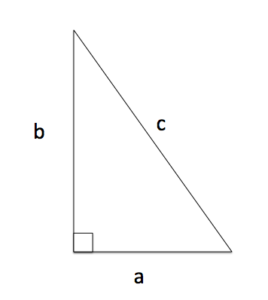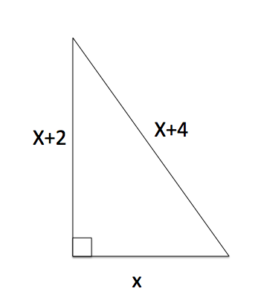Learning Outcomes
- Recognize a right triangle from other types of triangles

Some common types of triangles.
The Pythagorean theorem or Pythagoras’s theorem is a statement about the sides of a right triangle. One of the angles of a right triangle is always equal to [latex]90[/latex] degrees. This angle is the right angle. The two sides next to the right angle are called the legs and the other side is called the hypotenuse. The hypotenuse is the side opposite the right angle, and it is always the longest side. The image above shows four common kinds of triangle, including a right triangle.

A right triangle with sides labeled.
The Pythagorean theorem is often used to find unknown lengths of the sides of right triangles. If the longest leg of a right triangle is labeled c, and the other two a, and b as in the image on the left, The Pythagorean Theorem states that
[latex]a^2+b^2=c^2[/latex]
Given enough information, we can solve for an unknown length. This relationship has been used for many, many years for things such as celestial navigation and early civil engineering projects. We now have digital GPS and survey equipment that have been programmed to do the calculations for us.
In the next example, we will combine the power of the Pythagorean theorem and what we know about solving quadratic equations to find unknown lengths of right triangles.
Example
A right triangle has one leg with length x, another whose length is greater by two, and the length of the hypotenuse is greater by four. Find the lengths of the sides of the triangle. Use the image below.

The following video example shows another way a quadratic equation can be used to find unknown side lengths of a right triangle.
If you are interested in celestial navigation and the mathematics behind it, watch the video below for fun.
Candela Citations
- Pythagorean Theorem, Description and Examples. Provided by: Lumen Learning. License: CC BY: Attribution
- Factoring Application - Find the Lengths of Three Sides of a Right Triangle (Pythagorean Theorem). Authored by: James Sousa (Mathispower4u.com) for Lumen Learning. Located at: https://youtu.be/xeP5pRBqsNs. License: CC BY: Attribution
- Celestial Navigation Math. Authored by: TabletClass Math. Located at: https://www.youtube.com/watch?v=XWLZKmPU17M. License: All Rights Reserved. License Terms: Standard YouTube License
- Pythagorean Theorem. Provided by: Wikipedia. Located at: https://en.wikipedia.org/wiki/Pythagorean_theorem. License: CC BY-SA: Attribution-ShareAlike

